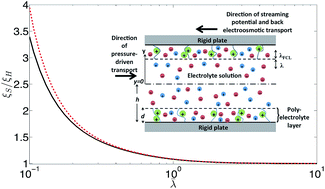Streaming potential and electroviscous effects in soft nanochannels: towards designing more efficient nanofluidic electrochemomechanical energy converters
Abstract
In this paper we provide analytical solutions for the streaming potential and electroviscous effects in soft nanochannels. The analysis is based on the solution of the linearized Poisson–Boltzmann equation, valid for small electrostatic potentials. We identify the important dimensionless parameters that dictate these two effects. Results are provided for a large range of electric double layer (EDL) thickness values, spanning from the case of very thin to very large overlapped EDL thicknesses. We compare the results with those of a rigid nanochannel, having zeta potential equal to the electrostatic potential at the solid-polyelectrolyte interface of the soft nanochannels. For the soft nanochannel, the streaming potential varies very weakly with the EDL thickness and can be substantially larger than that corresponding to the rigid nanochannel. The electroviscous effects for the soft nanochannel, unlike the rigid nanochannel, virtually always exhibit a monotonic decrease with the EDL thickness, and for certain parameter ranges can be several times larger than that for a rigid nanochannel. Most importantly, for the soft nanochannels the electrochemomechanical energy conversion, associated with the generation of streaming potential, is found to be highly efficient, with the efficiency being several times higher than that of a rigid nanochannel.


 Please wait while we load your content...
Please wait while we load your content...